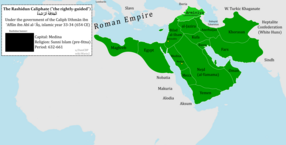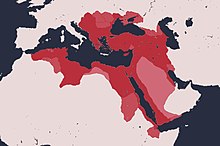Islam in Saudi Arabia
Islam is the state religion of Saudi Arabia, officially known as the Kingdom of Saudi Arabia, which is located in the Arabian Peninsula. Saudi Arabia is the place of pilgrimage - a journey made by followers of a religion - for Muslims across the world. It is where two Islamic holy cities exist, called Mecca and Medina.
Birth of Islam[change | change source]
The First Quranic Revelation[change | change source]
The Prophet Muhammad was born in Mecca in 570 A.D[1][2]. He lived in what is now called Saudi Arabia. The first year of the Arabic calendar begins in 622 A.D, when Muhammad moves (in Arabic, hijra) from Mecca to Medina. These are the two holy cities in Islam, which are in Saudi Arabia[3]. The pre-Islamic name for Medina is Yathrib. This is the word used by the Prophet Muhammad[4].
The Qur'an was revealed to Muhammad across 23 years. They began when he 40 years old until his death at 63. The first revelation happened during the month called Ramadan. The revelation was brought by the angel Gabriel, who told him to repeat the word of God (in Arabic, Allah)[5].
- "Read in the name of your Lord who created
- Created man from a clinging substance.
- Read, and your Lord is most Generous–
- He who taught by the pen–
- Taught man that which he knew not."[6]
After the death of Prophet Muhammad[change | change source]

After the Prophet Muhammad's death, the Arabian Peninsular had united into one Muslim community because of his military conquest. This was done by the conquering of many Arabian tribes, including the Quraysh tribe (the tribe that the Prophet belonged to [2]), the Aws tribe, and lots of smaller Jewish communities[7].
The first four men to lead the Muslim community after the death of the Prophet Muhammad are known as the Rashidun, which means rightly guided in Arabic[8]. These four Caliphs (which means means 'successor of Muhammad' in Arabic[9]) were Abu Bakr, Umar, Uthman, and Ali. Many Muslims believe that this was the last generation of true Muslim leaders, which is why there are known as the Rashidun[10].
Islam in Medieval Arabia[change | change source]
Sunni movements[change | change source]
In the medieval period, the Arabian peninsula was united under multiple Islamic empires, called Caliphates. These empires were mostly Sunni empires. Sunni is one of two branches of Islam. Sunni Muslims believe the legitimacy of Muslim rulers came from their level of adherence to Muslim values, such as performing the pilgrimage Hajj, doing jihad, and ruling by Islamic law[11]. Sunni Islam is the branch of Islam that is still the most widely practiced in Saudi Arabia today[12].
| Empire (Caliphate) | Kings (Caliphs) | Period | Map |
|---|---|---|---|
| Umayyad Caliphate | 14 Caliphs, including Muawiya I ibn Abu
Sufyan (first Caliph[13]) and Umar ibn Abd al-Aziz, who is credited with making the empire more efficient[14]. |
661-750 A.D[15] |  |
| Abbasid Caliphate | 37 Caliphs, including al-Saffāḥ[16] (the first Caliph, and relative of Prophet Muhammad's uncle) and al-Manṣūr (who founded the city of Baghdad[17]). | 750 -1258 A.D[18] |  |
| Ayyubid Empire (or Sultanate) | 9 Sultans (rulers), including the founder Saladin, who fought against French, English and Roman forces in the Third Crusade[19]. | 1171–1260 A.D[20] |  |
| Mamluk Empire
(or Sultanate) |
53 Sultans, including Tumanbay II (the last Sultan[21]). | 1250 - 1517 A.D[22] |  |
| Ottoman Empire | 36 Sultans[23], including Osman I (founder), and Mehmed II (conquered Constantinople[24]). | 1299 - 1922 A.D[25] |  |
Shi'ite movements[change | change source]
The second main branch of Islam is called Shi'ism. There are less Shia Muslims in the world than Sunni Muslims.[26] There were less Shia empires than Sunni empires in Arabia. They are more powerful in Persia (Iran), where they have ruled since 791 A.D[27]. Shi'ites, unlike Sunni Muslims, believe that leaders should be related to the Prophet Muhammad[28] and the fourth Caliph, Ali.
| Caliphate | Caliphs | Period | Map |
|---|---|---|---|
| Fatimid Empire | 14 Caliphs, including al-Hakim bi-Amr Allah
(who saw the mass conversion of many Christians and Jews in Egypt)[29]. |
909 - 1171 A.D[30] |  |
Islam and the House of Saud[change | change source]
Muhammad ibn Abd-al Wahhab[change | change source]
Muhammad ibn Abd-al Wahhab (Arabic: مُحَمَّد بْن عَبْد ٱلْوَهَّاب بْن سُلَيْمَان ٱلتَّمِيمِيّ), known also as ibn-Wahhab, was an Islamic scholar and thinker who lived in the eighteenth century in Arabia. He believed that the modern, Western world had made Muslims unfaithful to their religion because of practices like the worshiping of idols (in Arabic, shirk, which is strictly prohibited in Islam[31]). Ibn-Wahhab argued that Muslims must stop using medieval traditions and thought. Instead, they should directly use the Qur'an and the hadith (the writings about the life of the Prophet Muhammad[32]) to adhere to Islamic law[33].
Hajj[change | change source]

The Hajj is a pilgrimage to the Kaaba, a stone monument that is covered in black silk. It is in Mecca. The Hajj began as a formal pilgrimage in the seventh century, when the Prophet Muhammad was alive[34][35]. Hajj is one of five ‘pillars’ of Islam[36]. This means it is one of the obligatory acts of worship for Muslims. The Hajj also includes many other rituals during the forty day event. These include walking around the Kaaba in a circle (in Arabic, tawaf) and travelling in between the hills of Safa and Mawra 7 times [37][38].
Millions of Muslims travel for the Hajj every year. For the 2023 season, the number of visitors for the Hajj was about 1.8 million, the majority of them male [39]. The number of women partaking in the Hajj has increased from one-third to nearly one-half over the last 40 years[40].
Hajj Infrastructure[change | change source]

This modernisation includes the building of new train lines, with a 450km metro line that connects Mecca to Medina[41]. The modernisation of the Hajj pilgrimage route caused the destruction of more than 300 historical buildings in the past sixty years[42].
The Saudi Federation for Cybersecurity, Programming and Drones (SAFCSP) organised a "Hajj hackathon" in Jeddah. Engineers had to introduce new technologies to facilitate the pilgrims experience in Saudi Arabia.[43] This contest was created to find ways to prevent deadly accidents and natural disasters that have impacted the Hajj in the past[44].

European countries have tried to get involved in the Hajj for economic reasons. A Dutch shipping union called Kongsi Tiga transported pilgrims to Saudi Arabia from the Dutch West Indies[45].
In 1986, King Ibn Saud the title "His Majesty" to include "Custodian of the Two Holy Mosques". This was to send the message that Mecca belongs to the Saudi King[3]. It has been used by every King since.
Population and demographic[change | change source]
The population of Saudi Arabia is estimated to be 35.4 million in 2022. About 21 million (85 to 90%) of the Saudis are Sunni Muslims. Shia Muslims are 10 to 12% of the Saudi citizen population[46]. They are mainly located in the eastern part of the country, near Qatar and Bahrain[47]. Saudi Arabia also has a non-Muslim population. There are about 2 million Christians and 700,000 Hindus living in Saudi Arabia[12].
Legal system[change | change source]
The country's official religion is Islam. The constitution is based is the Qu'ran and Sunna[48] (rules based on prophet Muhammad's life). The legal system is based on Sharia law, which is given by God and interpreted by religious scholars[49]. The features of the Saudi government and legal system are stated in the 1992 Basic Law of Governance. It states the importance of national unity and education, family, virtue and Islam for the society of Saudi Arabia[50].
The Basic Law of Governance states many religious crimes which are punishable by death. For example, the charge of apostasy (in Arabic, ridda, which means a Muslim changing his religion[51]) is punishable by death. This has not happened in recent years. Also, anti-terrorism laws state that it is a criminal act to question the basics Islam, or promoting atheist (non-religious) thought. Some non-Muslim foreigners who wish to gain citizenship must show they have become Muslim [12].
References[change | change source]
- ↑ The Pluralism Project (2020). "Muhammad: The Messenger of God" (PDF).
- ↑ 2.0 2.1 Morrissey, Fitzroy (2022). A short history of Islamic thought. New York: Oxford University Press. p. 7. ISBN 978-0-19-752201-1.
- ↑ 3.0 3.1 Robinson, Chase (2010), Robinson, Chase F. (ed.), "The rise of Islam, 600–705", The New Cambridge History of Islam: Volume 1: The Formation of the Islamic World, Sixth to Eleventh Centuries, The New Cambridge History of Islam, vol. 1, Cambridge: Cambridge University Press, pp. 171–225, doi:10.1017/chol9780521838238.007, ISBN 978-0-521-83823-8, retrieved 2024-04-16
- ↑ Morrissey, Fitzroy (2022). A short history of Islamic thought. New York: Oxford University Press. p. 8. ISBN 978-0-19-752201-1.
- ↑ "Teachers Guide - Muslims | Teacher Center | FRONTLINE | PBS". www.pbs.org. Retrieved 2024-04-16.
- ↑ Abdel Haleem, M. A.; Abdel Haleem, M. A., eds. (2005). The Qur'an. Oxford world's classics (First publ., with corrections, as an Oxford World's Classics paperback ed.). Oxford: Oxford Univ. Press. pp. xiv. ISBN 978-0-19-283193-4.
- ↑ Rodgers, Russ (2012). The generalship of Muhammad: battles and campaigns of the Prophet of Allah. Gainesville (Fa.): University Press of Florida. pp. 109–110, 232. ISBN 978-0-8130-3766-0.
- ↑ Esposito, John L. EspositoJohn L. (2022-05-19), Esposito, John L. (ed.), "Caliph", The Islamic World: Past and Present, Oxford University Press, doi:10.1093/acref/9780195165203.001.0001/acref-9780195165203-e-56?rskey=2lzemw&result=3, ISBN 978-0-19-516520-3, retrieved 2024-05-05
- ↑ Dent, Susie (2012), "Caliph", Brewer's Dictionary of Phrase & Fable, Chambers Harrap Publishers, doi:10.1093/acref/9780199990009.001.0001/acref-9780199990009-e-1832?rskey=2lzemw&result=4, retrieved 2024-05-05
- ↑ Perry, Glenn E. (2009), "Caliph", The Oxford Encyclopedia of the Islamic World, Oxford University Press, doi:10.1093/acref/9780195305135.001.0001/acref-9780195305135-e-0131?rskey=2lzemw&result=7, ISBN 978-0-19-530513-5, retrieved 2024-05-05
- ↑ Kerr, Anne KerrAnne; Wright, Edmund WrightEdmund (2015-07-23), Kerr, Anne; Wright, Edmund (eds.), "Sunni", A Dictionary of World History, Oxford University Press, doi:10.1093/acref/9780199685691.001.0001/acref-9780199685691-e-3532?rskey=fppbve&result=2, ISBN 978-0-19-968569-1, retrieved 2024-05-03
- ↑ 12.0 12.1 12.2 Office of International Religious Freedom (2022). "Saudi Arabia 2022 International Religious Freedom Report". 2022 Report on International Religious Freedom: Saudi Arabia.
- ↑ Clarke, Nicola ClarkeNicola (2018-03-22), "Mu'awiya I b. Abi Sufyan", The Oxford Dictionary of Late Antiquity, Oxford University Press, doi:10.1093/acref/9780198662778.001.0001/acref-9780198662778-e-3249?rskey=jw0cxb&result=3, ISBN 978-0-19-866277-8, retrieved 2024-05-03
- ↑ "Umar ibn Abd al-Aziz". Oxford Reference. doi:10.1093/oi/authority.20110803110555957. Retrieved 2024-05-03.
- ↑ Esposito, John L. EspositoJohn L. (2022-05-19), Esposito, John L. (ed.), "Umayyad Caliphate", The Islamic World: Past and Present, Oxford University Press, doi:10.1093/acref/9780195165203.001.0001/acref-9780195165203-e-356?rskey=qdd09k&result=1, ISBN 978-0-19-516520-3, retrieved 2024-05-03
- ↑ Esposito, John L. EspositoJohn L. (2003-01-01), Esposito, John L. (ed.), "Saffah, Abu al-Abbas al-", The Oxford Dictionary of Islam, Oxford University Press, doi:10.1093/acref/9780195125580.001.0001/acref-9780195125580-e-2052?rskey=6g5nmc&result=1, ISBN 978-0-19-512558-0, retrieved 2024-05-03
- ↑ "Al-Manṣūr | ʿAbbāsid Caliph & Founder of Baghdad | Britannica". www.britannica.com. 2024-03-25. Retrieved 2024-05-03.
- ↑ Esposito, John L. EspositoJohn L. (2022-05-19), Esposito, John L. (ed.), "Abbasid Caliphate", The Islamic World: Past and Present, Oxford University Press, doi:10.1093/acref/9780195165203.001.0001/acref-9780195165203-e-1?rskey=kcd7eq&result=2, ISBN 978-0-19-516520-3, retrieved 2024-05-03
- ↑ Cartwhite, Mark (27/08/2018). "Third Crusade". World History Encyclopedia.
{{cite web}}: Check date values in:|date=(help) - ↑ Bloom, Jonathan M. BloomJonathan M.; Blair, Sheila S. BlairSheila S. (2009), "Ayyubid", The Grove Encyclopedia of Islamic Art and Architecture, Oxford University Press, doi:10.1093/acref/9780195309911.001.0001/acref-9780195309911-e-114?rskey=b32ofb&result=1, ISBN 978-0-19-530991-1, retrieved 2024-05-03
- ↑ Morby, John (2014-09-18), "Egypt, Islamic", Dynasties of the World, Oxford University Press, doi:10.1093/acref/9780191780073.001.0001/acref-9780191780073-e-72?rskey=1i42ov&result=1, ISBN 978-0-19-178007-3, retrieved 2024-05-03
- ↑ Amitai, Reuven (2010), "Mamluks", The Oxford Encyclopedia of Medieval Warfare and Military Technology, Oxford University Press, doi:10.1093/acref/9780195334036.001.0001/acref-9780195334036-e-0581?rskey=rn8txk&result=5, ISBN 978-0-19-533403-6, retrieved 2024-05-03
- ↑ "Ottoman Empire - WWI, Decline & Definition". HISTORY. 2020-02-28. Retrieved 2024-05-03.
- ↑ Kerr, Anne KerrAnne; Wright, Edmund WrightEdmund (2015-07-23), Kerr, Anne; Wright, Edmund (eds.), "Mehmed II", A Dictionary of World History, Oxford University Press, doi:10.1093/acref/9780199685691.001.0001/acref-9780199685691-e-2371?rskey=c59761&result=1, ISBN 978-0-19-968569-1, retrieved 2024-05-03
- ↑ Kerr, Anne KerrAnne; Wright, Edmund WrightEdmund (2015-07-23), Kerr, Anne; Wright, Edmund (eds.), "Ottoman empire", A Dictionary of World History, Oxford University Press, doi:10.1093/acref/9780199685691.001.0001/acref-9780199685691-e-2739?rskey=8agqsd&result=3, ISBN 978-0-19-968569-1, retrieved 2024-05-03
- ↑ "Mapping the Global Muslim Population". Pew Research Center. 2009-10-07. Retrieved 2024-05-05.
- ↑ Bailey, Harold Walter; Gray, Basil; Frye, Richard Nelson (1975). The Cambridge history of Iran. University of Cambridge. Cambridge, New York ; Melbourne: Cambridge university press. ISBN 978-0-521-20093-6.
- ↑ Anzalone, Christopher AnzaloneChristopher (2008-01-01), "Shia", The Oxford Encyclopedia of the Modern World, Oxford University Press, doi:10.1093/acref/9780195176322.001.0001/acref-9780195176322-e-1442?rskey=qerbz5&result=2, ISBN 978-0-19-517632-2, retrieved 2024-05-03
- ↑ werthmuller, kurt werthmullerkurt (2011-01-01), "Hakim, al-", Dictionary of African Biography, Oxford University Press, doi:10.1093/acref/9780195382075.001.0001/acref-9780195382075-e-0801?rskey=ytlniz&result=1, ISBN 978-0-19-538207-5, retrieved 2024-05-03
- ↑ "caliphate, Fatimid", The Oxford Dictionary of the Middle Ages, Oxford University Press, 2010-01-01, doi:10.1093/acref/9780198662624.001.0001/acref-9780198662624-e-1114?rskey=ncmfpi&result=6, ISBN 978-0-19-866262-4, retrieved 2024-05-03
- ↑ Fletcher, Charles (2009), "Shirk", The Oxford Encyclopedia of the Islamic World, Oxford University Press, doi:10.1093/acref/9780195305135.001.0001/acref-9780195305135-e-1080?rskey=plx5xn&result=5, ISBN 978-0-19-530513-5, retrieved 2024-05-05
- ↑ Hammond, Marlé (2018-02-15), "ḥadīth", A Dictionary of Arabic Literary Terms and Devices, Oxford University Press, doi:10.1093/acref/9780191836954.001.0001/acref-9780191836954-e-70?rskey=ruvbud&result=1, ISBN 978-0-19-183695-4, retrieved 2024-05-05
- ↑ Esposito, John L. EspositoJohn L. (2003-01-01), Esposito, John L. (ed.), "Ibn Abd al-Wahhab, Muhammad", The Oxford Dictionary of Islam, Oxford University Press, doi:10.1093/acref/9780195125580.001.0001/acref-9780195125580-e-916?rskey=1xqgf5&result=1, ISBN 978-0-19-512558-0, retrieved 2024-05-05
- ↑ "Hajj | Definition, Importance, & Facts | Britannica". www.britannica.com. 2024-03-29. Retrieved 2024-05-05.
- ↑ Mayeur-Jaouen, Catherine (2002), "hajj", Encyclopedia of the Middle Ages, James Clarke & Co, doi:10.1093/acref/9780227679319.001.0001/acref-9780227679319-e-1256?rskey=jit51y&result=3, ISBN 978-0-227-67931-9, retrieved 2024-05-05
- ↑ "Hajj", World Encyclopedia, Philip's, doi:10.1093/acref/9780199546091.001.0001/acref-9780199546091-e-5037?rskey=wpnfnw&result=1, ISBN 978-0-19-954609-1, retrieved 2024-05-05
- ↑ "What is Hajj? A step-by-step guide to the Muslim pilgrimage". Al Jazeera. Retrieved 2024-04-18.
- ↑ Esposito, John L. EspositoJohn L. (2022-05-19), Esposito, John L. (ed.), "Hajj", The Islamic World: Past and Present, Oxford University Press, doi:10.1093/acref/9780195165203.001.0001/acref-9780195165203-e-124?rskey=dj7661&result=5, ISBN 978-0-19-516520-3, retrieved 2024-05-03
- ↑ "'Largest Hajj pilgrimage in history' begins in Saudi Arabia". Al Jazeera. Retrieved 2024-04-18.
- ↑ Bianchi, Robert (2009), "Ḥajj", The Oxford Encyclopedia of the Islamic World, Oxford University Press, doi:10.1093/acref/9780195305135.001.0001/acref-9780195305135-e-0289?rskey=jit51y&result=4, ISBN 978-0-19-530513-5, retrieved 2024-05-05
- ↑ "How Saudi Arabia's high-speed railway allows Hajj pilgrims to travel in comfort and style". Arab News. 2023-06-30. Retrieved 2024-04-21.
- ↑ Amanullah, Shahed (2009). ""Hajj 2.0: Technology's Impact on the Muslim Pilgrimage"". Georgetown Journal of International Affairs.: 75–82 – via JSTOR.
- ↑ "Saudi Arabia looks to technology to make hajj safer". www.ft.com. Retrieved 2024-04-21.
- ↑ Staff (2006-01-13). "A history of hajj tragedies". The Guardian. ISSN 0261-3077. Retrieved 2024-05-03.
- ↑ Miller, Michael B. (2006). "Pilgrims' Progress: The Business of the Hajj". Past & Present (191): 189–228. ISSN 0031-2746.
- ↑ Department of State, U.S (2022). "Report on International Religious Freedom : Saudi Arabia, sections I and II". U.S Department of State.
- ↑ Rigoulet-Roze, David (2009-06-09). "The Shias of the Saudi Province of Al-Ahsa: A Few "National" Strategic Issues at the Heart of Regional Ethno-Confessional Challenges". Herodote (in French). 133 (2): 108–135. ISSN 0338-487X.
- ↑ Al-Atawneh, Muhammad (2009). "Is Saudi Arabia a Theocracy? Religion and Governance in Contemporary Saudi Arabia". Middle Eastern Studies. 45 (5): 721–737. ISSN 0026-3206.
- ↑ Mallat, Chibli MallatChibli (2012-11-22), "Sharia", The Oxford Companion to Comparative Politics, Oxford University Press, doi:10.1093/acref/9780199738595.001.0001/acref-9780199738595-e-353?rskey=nhsnjw&result=2, ISBN 978-0-19-973859-5, retrieved 2024-05-05
- ↑ "Basic Law of Governance | The Embassy of The Kingdom of Saudi Arabia". www.saudiembassy.net. Retrieved 2024-05-01.
- ↑ Bowker, John (2003-01-01), "Ridda", The Concise Oxford Dictionary of World Religions, Oxford University Press, doi:10.1093/acref/9780192800947.001.0001/acref-9780192800947-e-6087?rskey=w8vk4r&result=1, ISBN 978-0-19-280094-7, retrieved 2024-05-05
